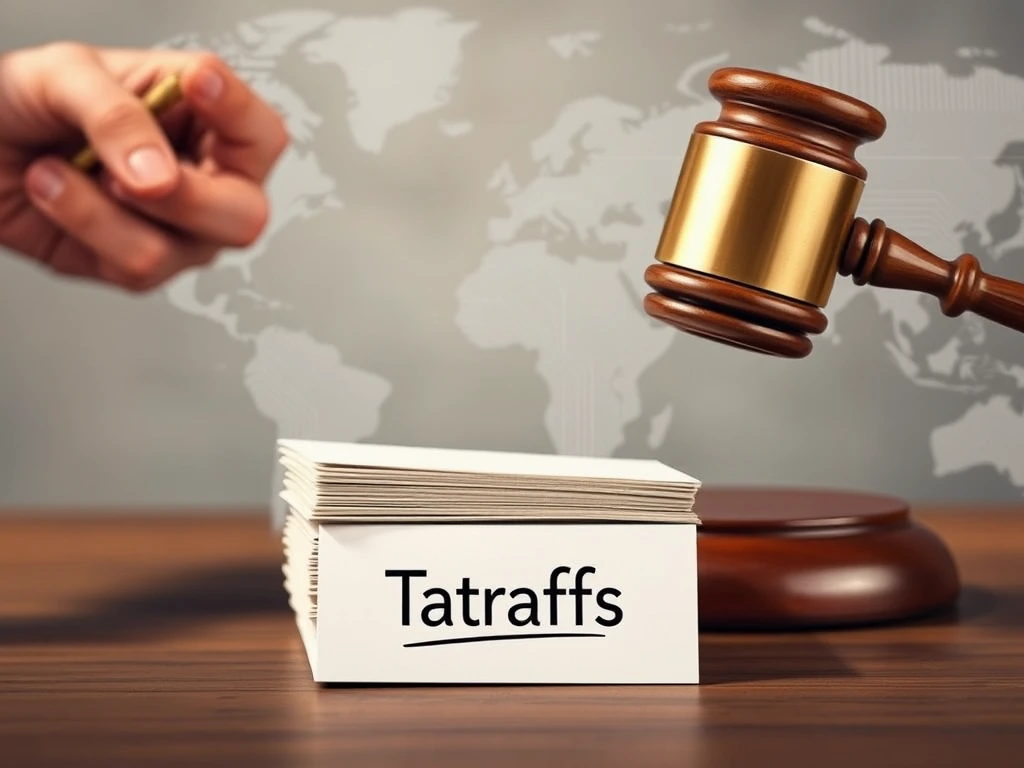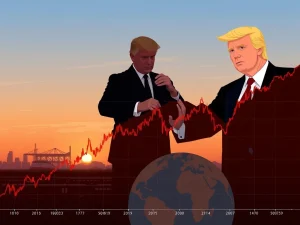Trump Tariffs: A Precarious Legal Challenge and Potential Crypto Impact

Donald Trump’s tariff program, often dubbed the “Liberation Day” tariff, has become a major point of contention, not just for businesses and consumers, but critically, in the legal arena. As 13 states sue the government, questioning the very foundation of these levies, many in the crypto world are watching. Could this legal fight over Trump tariffs create ripples that reach the digital asset space?
Trump Tariffs: The Legal Basis Under IEEPA
When President Trump initiated his widespread tariffs, many wondered about the source of his authority. Unlike historical tariffs set by Congress, these were unilateral executive actions. The power isn’t inherent in the President’s constitutional role (Article II). Instead, it stems from authority delegated by Congress over centuries.
Historically, Congress held the reins on trade duties, as outlined in Article I, Section 8. This led to infamous acts like the Smoot-Hawley Tariff of 1930. Recognizing the economic fallout from such political maneuvering, President Franklin D. Roosevelt pushed for the Reciprocal Trade Agreement Act of 1934 (RTAA), allowing the president to negotiate reciprocal tariff reductions.
However, Trump’s tariffs aren’t reciprocal. They rely on later delegations, notably the International Emergency Economic Powers Act of 1977, or IEEPA law. IEEPA allows the president to act during a declared national emergency to regulate international economic transactions, typically used for sanctions against hostile nations. Trump declared a “national emergency posed by the large and persistent trade deficit” and used IEEPA to impose tariffs, a novel application many legal experts find questionable.
The Tariffs Legal Challenge: States, Businesses, and Core Arguments
The controversial application of IEEPA quickly triggered lawsuits. While some businesses reportedly hesitated, states stepped forward, led by California and later joined by a dozen others. Their core arguments against the Trump tariffs are twofold:
- Ultra Vires: The states argue that imposing broad, worldwide tariffs based on a trade deficit emergency goes beyond the authority granted by IEEPA, which is meant for targeted responses to unusual threats. They contend the tariffs aren’t tailored to the declared emergency.
- Nondelegation Doctrine: This constitutional principle limits Congress’s ability to delegate its powers to the executive branch. While courts have historically been deferential, delegation is supposed to be guided by an “intelligible principle.” The states argue that using IEEPA for such broad, unilateral tariffs amounts to an unconstitutional delegation of Congress’s Article I power without sufficient guidance.
This nondelegation argument hasn’t succeeded in striking down executive action since 1935 (Panama Refining Co. v. Ryan), highlighting the uphill battle, but legal scholars still see it as a strong theoretical challenge.
Navigating the Courts: Venues and Political Questions
The legal fight isn’t just about the arguments; it’s also about where the cases are heard. Most tariff disputes fall under the exclusive jurisdiction of the US Court of International Trade (CIT), whose appeals go to the Federal Circuit, often seen as favorable to the government. While some states filed in CIT, California initially filed in a different federal court (Northern District of California), potentially seeking a less deferential venue. The administration is attempting to move that case to CIT, which would be an early procedural win for them.
A key defense for the administration is the “political question doctrine.” Rooted in cases like Marbury v. Madison, this doctrine suggests courts should avoid issues deemed purely political and best left to the executive or legislative branches. The administration argues that the president’s declaration of a national emergency under the National Emergencies Act and the policy choices made under IEEPA are political questions beyond judicial review. The success of this argument is uncertain, and courts have historically used it to avoid difficult issues, particularly in foreign policy contexts.
While the administration has defenses, President Trump’s overall track record in court, particularly the Supreme Court, has been weaker than average, suggesting these legal challenges are formidable.
Potential Crypto Impact Amidst US Trade Policy Uncertainty
So, where does crypto fit into this complex legal and trade landscape? Traditionally, tariffs apply to physical goods crossing borders. They don’t directly impact services or intangible digital assets like cryptocurrencies.
As this tariffs legal challenge unfolds and global trade relationships become more unpredictable due to changing US trade policy, the indirect crypto impact tariffs could become more pronounced. Cryptocurrencies like Bitcoin are borderless and exist outside traditional financial and trade systems built around national currencies and tariffs.
If escalating trade conflicts or protectionist policies disrupt conventional international trade and payment systems, the appeal of a decentralized, censorship-resistant medium for cross-border transactions could increase. While currently unaffected, the long-term consequence of prolonged trade uncertainty could be a validation for crypto as an alternative for international commerce, particularly if traditional trade mechanisms face increasing friction.
Conclusion
The legal battle over Donald Trump’s tariffs is a significant test of executive power and constitutional limits. Whether the states succeed in proving the tariffs are a legal house of cards remains to be seen, resting on interpretations of laws like IEEPA and doctrines like nondelegation and political question. Regardless of the outcome, the ongoing disruption and uncertainty in US trade policy highlight the potential vulnerabilities of traditional systems. While tariffs don’t directly touch digital assets, the broader environment of trade conflict and economic instability could inadvertently accelerate the exploration and adoption of cryptocurrencies as resilient tools for international trade in an increasingly unpredictable world.








